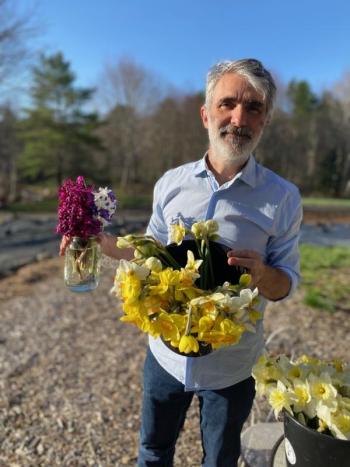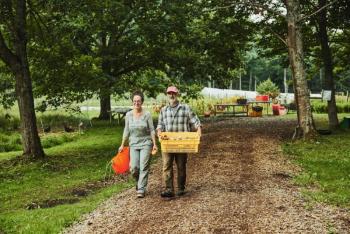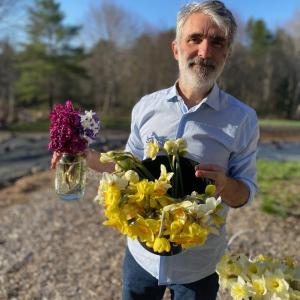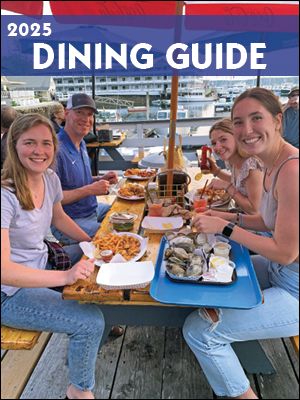Petit à Petit: On farming, macarons and feeding community
This is the story of the seed of an idea and the field where it was planted. Eventually the story leads to a harvest that feeds a community. But before all of this, Alain Ollier went for a run.
Trading his rubber boots for a pair of running shoes, Alain left his cedar shingle farmhouse. He passed the elm tree, the little garden, the fallow fields on the property in Newcastle he had bought a few years earlier with his wife Erica Berman when they moved from Paris. He turned onto the back roads that had become familiar terrain, picking up his pace at the crest of the hill. Alain was training for a marathon, inspired by “Chi Running,” a book he had come across in a thrift shop. On even the coldest mornings that winter, Alain ran — his orange hat punctuating the snowy landscape as he accumulated mile after mile towards his goal. He had lots of time to think. Alain became preoccupied with the knowledge that families in Maine were struggling. It was impossible to ignore the fact that one in seven people in Maine do not have enough food on their tables daily, or that nearly half of Maine students would go hungry without school meals. In April of that year, after Alain crossed the finish line of the Boston Marathon, he sent a check to Healthy Lincoln County to help provide students in need with meals during their summer vacation.
The experience changed him. When Alain looked out at his empty field, which had once been a hunting camp owned by the widow of a Vietnam veteran, he thought about the legacy of the property and the potential for it to be cultivated for good. The idea took hold for a “grow to donate” farm, working to end hunger in Maine. Alain and Erica had no farming experience, but they had the confidence to plow ahead.
The first season of Veggies To Table was challenging and exciting. In March of 2019, with the help of a part-time farm manager and some local students from Lincoln Academy, Alain and Erica planted a crop of seedlings — lining up trays on four shelves upstairs in their farmhouse under grow lights. To harden them during the day, they carried the trays out into the sun. In the evenings, they brought the trays in to protect them from frost.
All through that year and the next, Alain and Erica found opportunities to feed people, body and soul. They tucked bouquets of flowers alongside fresh produce in box after box headed to families who rely on pantries, to schools and summer lunch programs feeding children, to a mother whose life had been turned upside down with a car in need or repair and no money to buy groceries. That mother would later bring her four children to visit the farm, where they would learn how to grow food, becoming farmers as they pulled weeds, trellised tomatoes, and plucked peas. Looking back, the mother says of the experience that what was most important was watching her children learn what it means to put love into action.
Alain and Erica cleared more land, motivated by how they could reach more families. The first year, Veggies to Table donated more than 4,250 pounds of organic produce to over 30 organizations and partners. They grew and gave away more than a thousand flowers. They recruited more than 100 volunteers, interns and workers to start the farm.
Over time, the farm would expand to 1.3 producing acres. In six seasons, Veggies to Table has donated almost 80,000 pounds of fresh produce — organic snap peas, radishes, tomatoes, pumpkins, garlic, potatoes — and the flower garden has grown ten-fold. Their approach to farming, equity, and social justice has brought ease and security to people in an uneasy and insecure world, supporting people of different socio-economic and cultural backgrounds.
Along the way, Alain and Erica have created lasting connections and community. They became a family of volunteers and workers who have found purpose on the farm. Almost 60 years apart in age, Mary, with her hair silky smooth and henna dyed, and Merry, retired from a career in social services administration, work side-by-side to plant and weed. The youngest volunteer, Max, is here just for a few weeks. He is exuberant about life in general, if not about farming. But like Alain, he is a student of the world and is willing to try it out.
Alain has a sweet side. Growing up in France, Alain began cooking at the age of eight or nine, mastering the process of Creme Anglàise — stirring and stirring with a wooden spoon over low heat. He liked to test the results. He tested, tested, tested again — on at least one occasion young Alain overdid it with the testing. The unfortunate cake was served “nu” — naked — but Alain felt satisfied.
When Alain traveled to India, straightaway he directed the rickshaw driver to take him to the best pastry stand in town. He would think later about finding a place nearby to sleep. Alain remembers the petit Beignets aux Pommes in Rajastan and the taste of Goulab Jamu, a bite of almond dough fried and served in syrup. The flavors of pistachio and honey. In Calcutta he found Dahi, a thick yogurt served in little clay pots. Alain walked a mile each day for it, embracing the custom of breaking the emptied Dahi pot on the road as an expression of gratitude.
At Wiscasset Middle High School and later at Lincoln Academy, where Alain now teaches, he has found baking to be a way of connecting with his students and teaching them important life lessons. He began to teach “macaronage,” the art of making the sweet almond cookies that are ubiquitous in France, showing his students how to fold in the eggs, how to turn the bowl with their hands starting at twelve o’clock and six o’clock, meeting up at six o’clock and then back to twelve and six. He encourages his young students to be slow and patient, to lift the contents gently from the bottom of the bowl — the soufflé is important. He explains the need for powder dye, which keeps the macarons dry. When the pastry class was first offered, 12 students signed up immediately. Now there’s always a full kitchen as the students are introduced to the pleasures of pâte à choux, profiteroles, lemon meringue pie, mousse au chocolat.
It isn’t surprising that Alain became a teacher. With his students, Alain applies the same patience, the same underlying belief in the process of learning. For the student that does not have an immediate answer to a problem, there is a way to get there, by going back slowly, making adjustments, and trying again. Reese, a rising senior at Lincoln Academy, calls Alain’s approach to teaching “encouraging and simple,” even when the subject is as complex and nuanced as French patisserie.
“Education is tied to your freedom,” Alain tells me. “You have to be self sufficient. If you don’t know how to grow and prepare food, you are giving part of your freedom away. Children need the knowledge that ‘This is a tomato. This is how a tomato is supposed to taste.”
When Alain comes home from school, there is still much to do and much to learn on the farm. He’s taught himself how to use a chainsaw, how to irrigate crops, how to fix the plumbing. It’s trial and error. He watches YouTube or calls friends in the community. Alain always has a new project to challenge him. Right now, he is growing fruit trees. He’s put in varieties of apple, peach, pear and cherry. He is patient. “They will produce at some point.”
There has never been a time when Alain and Erica have questioned their decision to plant that first seed. “Try to do the good. What’s the failure?” Alain reflects. “Even if you grow one carrot and give it away you’ve succeeded.” This reminds me of the French saying: “Petit à petit, l'oiseau fait son nid.” “Little by little, the bird creates its nest."
For just a few days this summer, Alain and Erica are taking a rare break from the farm to attend a family wedding in France. Alain tells me that when there is a wedding, it is his family’s custom to create a book of family recipes for the newlyweds. For years, he has wanted to include the recipe for a cake he ate as a child, made by his grandmother. But Alain’s grandmother would not share her neighbor’s recipe, which had been given to her alone with a promise that she would take it to her grave. The neighbor died first, but Mamie stayed resolute. For his sister’s 18th birthday, Alain begged his grandmother for the recipe. Forty years later, Alain is still trying to replicate that cake, relying on his instincts for observation, on his tried and true method of trial and error. He knows what the cake should taste like, how it should smell. Alain is perfecting the recipe, which he will pass along freely to his young nephew, Adrien.
Creme Anglàise
Scrape a vanilla bean into a saucepan with 500 grams cream and 500 grams milk. Stir gently on a low heat. In a bowl, beat together 10 egg yolks in a bowl. Whisk in 200 grams of sugar and a pinch of kosher salt. Add a few spoonfuls of hot milk to the eggs while whisking. Then whisk the contents of the bowl into the saucepan. Stir, stir, stir until the creme thickens. If it coats the back of a wooden spoon it is ready. Remove the vanilla pod. Cool the creme to room temperature, whisking occasionally. Serve at room temperature or refrigerate and serve cold.






























